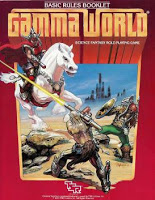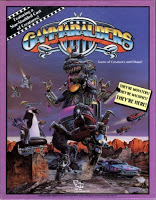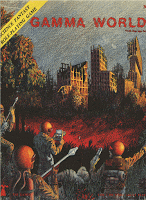I’ve been doing a little preliminary work on my massive Gamma World/Metamorphosis Alpha/Gammarauders/Gamma Knights (new element!) campaign, and something occurred to me.
Why in the Gamma World default campaign setting, does it seem like there aren’t any large nations? We’re centuries past the Big Oops, but it still seems like the only signs of civilization are tiny little hardscrabble villages and towns like Far-Go. There doesn’t seem to be any sense of a trade network and the communications that go with trade, no religions (!!!), and no governments that extend farther than the size of a city-state.
Now, maybe this is something that’s dealt with in later editions of the game (you know me, I stick with older versions of stuff whenever I can), but it seems entirely unlikely that in the centuries since the bombs fell, government hasn’t spread past the tiny village stage.
 This seems doubly unlikely given the fact that we have the cryptic alliances out there, supposedly spanning the world (or at least the North American continent). How are they organized? If they have agents in those hardscrabble villages, how do they communicate with one another if there aren’t any trade routes?
This seems doubly unlikely given the fact that we have the cryptic alliances out there, supposedly spanning the world (or at least the North American continent). How are they organized? If they have agents in those hardscrabble villages, how do they communicate with one another if there aren’t any trade routes?
For that matter, why aren’t there any nations? Have them separated by hundreds of miles of mutant-haunted wastelands, but surely there should be cities, and land to feed the cities, and towns to collect the produce of the land, and so forth. And with that comes manufacturing, at least at some level. Sure, maybe the secrets of the Ancients have been lost, and nobody knows how to make powered armor or artificial intelligence any more, but firearms should be easy enough.
The first edition rulebook does give this question some attention:
There should be a minimal number of cities in GAMMA WORLD, as there are simply too few survivors, and there hasn’t been time though, since the Shadow Years, for any great new cities to have grown. All of the old cities lie in radioactive ruin, or have been completely obliterated or swallowed up by the rising seas. What cities there are will generally be situated on a coast or river, and are near the few remaining robot farms (explained later). City populations should range between 5,000 to 50,000 humans, mutants, intelligent plants. etc.
In both the first and third editions of the game, the interval from the holocaust to the present day is 170 years or so. I submit that, population or no, that’s enough time for someone to extend their influence beyond the boundaries of a city-state, especially if they have populations reaching 50,000.
 These nations needn’t be too large, but even a city of 50,000 humans is going to need farmland, and that farmland needs villages to support it. Assuming there aren’t any handy robotic farms or computerized food factories handy.
These nations needn’t be too large, but even a city of 50,000 humans is going to need farmland, and that farmland needs villages to support it. Assuming there aren’t any handy robotic farms or computerized food factories handy.
I think adding that level to Gamma World would be a terrific way to add a whole layer of play to a campaign. Not only do you have local authorities, and agents of the cryptic alliances, but there are also (probably distant) rulers who have to be taken into account. And naturally those rulers go to war on occasion, which gives an excuse to have your bioborgs and associated popcorn assault an enemy town. It would also give those cryptic alliances a sandbox in which to pursue their schemes. I kinda like the idea, and will be incorporating it into my long-dreamed-of campaign.










There were nations, but they never made it into the basic rules set.
The "nations" of the Cryptic Alliances were outlined by Jim Ward in Dragon #25 (May 1979), which details the history of the alliances and plots out their locations on the GW map.
A reproduction of the map from Dragon #25 can be seen here:
http://www.darkshire.net/jhkim/rpg/gammahero/gwmap.gif
It is pretty much as you mention, small states separated by wide swaths of mutated wilderness…
I always thought the cryptic alliances were like dispersed states. Add enough badlands and destruction between and only a few militaristic ones would hold swaths of territory.
A city-state does include outlying villages and dependent communities, but its borders are basically limited by how far forces from the city can travel in time to repel raiders. The way city-states typically expand is either by annexing their neighbours (for security or control of resources), or by colonising (due to population pressure, or for trade or military purposes).
In the first case we'd see leagues of allied cities, or small empires with a capital city and several subordinates – possibly tributaries with limited rights, or else vassals ruled by governers from the capital. In the second case we'd see trade networks consisting of a mother city with several daughter-towns distributed along coasts or major rivers. The amount of control the metropole would have over the colonies depends on the distances involved, and there'd probably be breakaways, wars of independence and so on if they gripped too tightly.
It takes a long time for a unified polity to evolve – probably a lot longer than 170 years, though once they did they'd snowball. I figure arable land is in short supply in Gamma World, so I picture sweeping expanses of radioactive wastes separating narrow strips of farmland jostling with multiple competing cities formed into volatile and changeable power blocs.
James, do you know what hex scale that map uses?
I do not think it would be possible for humans to rebuild their civilization in GW. They've been shunted back into the Stone Age. They'd have to start all over again by learning to farm…er, maybe not, since the flora bites back. And they'd have to learn to domesticate animals…um, ah, the animals are now trying to domesticate humans. It's a non-starter. With no farming, none of the rest of technical civilization follows. Small groups for short amounts of time could carve out little enclaves of high-technology. But who do they call when their computer crashes? Now their robot-control network doesn't work (resulting in wild and/or uncontrolled and/or defunct robots), and all they have are a few hand-held weapons with, oh, 47 charges total. What happens after firing that 47th charge? Meanwhile, the mutants can fire those eyebeams from now until the cows come home. Plus those mutants are making little mutants. Nobody's making new high-tech items. Inhuman mutated insects and mutated microbes inherit the earth.
In a GW campaign I like to have a lot of "god-mutants" (as well as "god-computers" and robot "gods"). These "gods" are definitely not gods in the sense of A/D&D gods. They are simply powerful monsters that delusional beings worship. Of course, the primary form of worship would be sacrificing humans to them by giving them to their monster gods to eat.
Why would humans worship such monsters? Survival. Pure strain humans (unless armed to the teeth with the rare tech) are generally too weak to survive without protection from the mutated flora and fauna of Gamma World. In exchange for a steady stream of sacrifices, a mutant god would allow the pitiful humans to live in its vicinity. Humans would also tend to worship powerful computers and robots. The only humans not so benighted would be the vanishingly rare enclaves (typically from artificial satellites) of humans whose ancestors maintained pre-holocaust civilization and passed it down to them. They would still recognize high-tech as simply tools and not as gods. In fact, if other humans were to run into such pocket remnants of pre-holocaust civilization, they would probably treat those humans themselves as gods.
Have you ever considered doing a science fantasy adaptation for Adventures Dark & Deep? Could have some merit
I assume you read it a long time ago, but if not A Canticle for Leibowitz is a pretty good post holocaust rebuilding tale (and probably part of the DNA of Gamma World). In it the climb back toward civilization is exponential, but it takes a looong time before the upward curve away from the assymtote of zero becomes noticeable.
It would be more fun to build a nation than to just have one.
The map scale is "roughly 43.7 kilometers (27.3 miles) from side to side." According to one source quoting Jim Ward, this was Tom Wham's idea of a joke… I've usually went with 24 miles, just like they had back in the olden days with the Known World, though these days I'm more enamored of the 25 mile hex…
Bonparr looked like it was running pretty well.